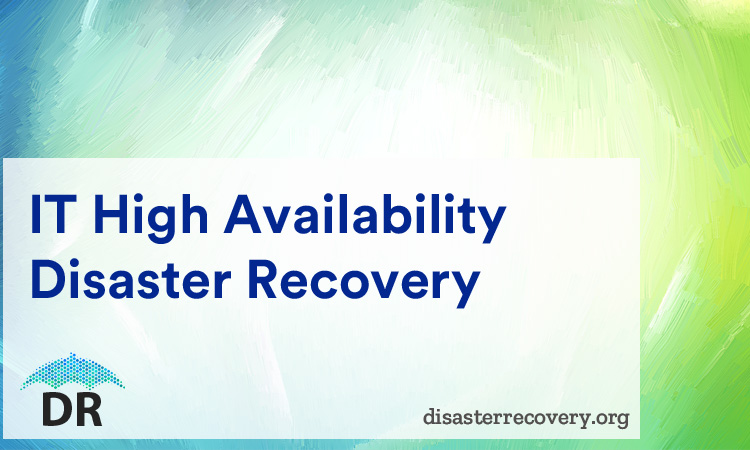High Availability [HA] is confused with Disaster Recovery [DR] frequently. When a system has High Availability it is fault tolerant or it has the ability to ‘fail over’. To illustrate High Availability at the sub level is the use of redundant power supplies in the system. By having such redundancies built into the system, even if the power fails from one source, it can immediately switch over to the redundant source. This fail over ability is what is described as High Availability infrastructure.
IT High Availability Disaster Recovery

Just because the infrastructure is designed to have High Availability, it does not achieve the goal of Disaster Recovery. High Availability is the ability of a system to switch over to a redundant system when there is a component failure in the system. In the case of Disaster Recover it is the use of resources and activities to restore IT services to normal operations in the shortest possible time by using an alternative production site or the cloud etc.
Some of the key differences between High Availability and Disaster Recovery are:
- High Availability uses redundancy in the system to overcome any component failure whereas Disaster Recovery uses an alternate site or cloud services to restore normal or near normal function of the entire production system.
- Unlike High Availability which is just a ‘fail over’ included in the system, Disaster Recovery has a wider footprint. It focuses on getting an alternate production site up and running when the primary site has been put out of action due to a disaster. Disaster Recovery includes recovery of data, restoring system functions and restarting production etc. using an off-site location or the cloud, as envisaged in the overall DR Plan.
- Disaster Recovery can handle multiple failures in the production center, including total loss of use of the center whereas High Availability can handle only a component failure such as power supply, memory loss or hardware failure etc.
- Disaster recovery uses trained staff, processes and hardware, deemed necessary to execute recovery, as per the DR Plan. The High Availability focuses on the technical design of the system to incorporate redundancies into crucial components of the available infrastructure.
When you compare Disaster Recovery and High Availability, the latter could be subsumed in the larger DR Plan. The basic infrastructure at the primary production site may incorporate multiple redundancies which can help in overcoming a disaster which affects only one part of the entire system. The High Availability failover design may be able to overcome total loss of power in one part of the infrastructure by using incorporated redundancies as per the High Availability design.
Such a configuration is seen when highly available cluster servers are used for an application in the production center, with back-up hardware in the off-site recovery center. The data is backed up in the recovery center and coupled with the High Availability design in the production center means that the system is relatively better protected at both ends.
An extreme example of this type of dual protection i.e. High Availability and Disaster Recovery is when servers are configured as ‘active-active’ or as a ‘continental cluster’ between two geographically diverse production and recovery centers. They are connected by a load balancer and very low latency data link. The data is backed up in both servers in real-time and both systems are active simultaneously. If either of the production centers has a failure, the other will take up its load and production can continue without pause.
High Availability and Disaster Recovery are two different concepts, which are apart but do link up, at times, for ensuring continuous production in the event of component failure or in the face of a disaster.

